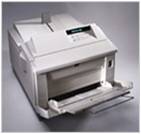- 31 reads
Spend $225 now and SAVE $50 each year... ROI = 22.2%
ENERGY STAR® printers can cut a printer’s electricity use by over 65 percent. A printer with a duplexing mode can also save around $30 a month in paper costs. There are several printer types—laser and ink jet—and several control options— standby mode and manual switching—to consider.
Laser printers are available with different printing speeds—the maximum energy draw of faster printers is greater than that of slower ones. A Lawrence Berkeley Lab paper showed that an eight page per minute (ppm) laser printer used 60 watts while a 24 ppm printer used 100 watts. Comparing the wattage alone is misleading, however. Since the larger printer prints faster, it doesn’t operate as long as the smaller one. In fact, the 24 ppm printer could use about 40 percent less energy for printing. Ink jet (or bubble jet) printers use much less energy. Instead of drawing 60 to 100 watts, they require only 10 to 15 watts. The trade-off with these printers is partly speed—they’re slower than the fastest laser printers—and partly quality.
Ink jet printers do not have quite the printing quality of laser printers. With the opportunity to cut printing energy by 75 to 90 percent, there may be times—for draft documents for example—where an ink jet printer is appropriate. ENERGY STAR® laser printers don’t need to be switched off manually. When no print commands have been received for a preset time period, these printers automatically switch to a low-power standby mode. The energy savings are significant: Laser printers save 65 to 75 watts in standby mode. While in standby, printers produce less heat, reducing air-conditioning costs too. With fewer operating hours and less heat buildup, these printers can last longer and be more reliable.
Like printers, copiers use energy all day (and night) even when making copies only a small fraction of that time. ENERGY STAR® labeled copiers are equipped with a feature that allows them to automatically turn off after a period of inactivity. This can cut electricity use by over 60 percent. Even non- ENERGY STAR® copiers can be manually turned off in the evenings and over the weekend.
All office staff can help with this. The average annual operating cost of a large copier left on at night is $224 versus $80 if you turn it off at night. The right copier can also save you paper. Copiers with duplexing capabilities set to automatically make double-sided copies can cut your paper costs. Since copiers are so expensive most businesses lease them. The average monthly lease for a copier is $550 for an $18,000 copier, so make sure to ask for an ENERGY STAR® certified copier on your next lease. You will save $150 annually, which is just over 2% of the $6,600 cost but you do not necessarily have to spend more to get the higher efficiency hardware.
When it comes to printers, look for quality ink jet or laser printers that include features like 'Eco-Mode', which enable you to minimize power consumption and paper waste. Ink jets are more energy efficient than laser printers, but you may need the advantages of laser for your office. Because so many manufactures have joined the ENERGY STAR® program, power saving features have become nearly standard on many types of equipment. As a result, energy-efficient equipment often costs no more than standard efficiency.
The ROI Calculation is based on the delta between ENERGY STAR® replacement cost for one new printer at $500 with an average energy savings of $50 per year. You can find printers without the eco-mode features that run $275, so the added cost for this calculation is $225.
| Payback Time in Years: |
Added Cost: |
Annual SAVINGS |
5 Year SAVINGS |
Return on Investment (ROI): |
| 4.5 | $225 | $50 | $250 | 22.2% |


